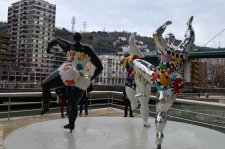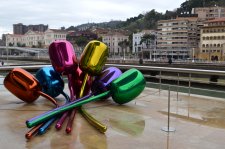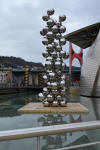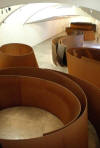Round The World and other travels
A frequent flyer's collection of trip diaries
This is: Northern Spain 2015
Guggenheim to Pintxo Central
After a brief foray outdoors during which no suitable alternatives came to light, we opted to have breakfast in the hotel. It was much busier than expected and the food proved to be uninspiring. In accordance with the plan, we then checked out and placed our luggage in storage for later in the day. Stepping outside for the second time, it didn't seem too bad as mornings go. Certainly the skies were grey and the ground was still damp from the Saturday-night rain, but all things considered, it seemed a reasonable introduction to the month of March. This morning's plan necessarily revolved around the fact that we held timed entry tickets for the Guggenheim Museum, purchased in advance over the Internet. As such, we needed to ensure that we would pass through the barriers sometime between 10-11am. Our walk took us along the banks of the Nervión, in the opposite direction to our Old Town stroll the previous evening. We crossed to the other bank using the striking new Zubizuri footbridge, designed by Santiago Calatrava. Having just landed on the left bank, something prompted me to realise that my driving licence was in my stored bag, rather than on my person. The best laid plans ...
Following a brisk retracing of steps, I caught up with Bruce at the museum's main door, still in plenty of time for our allocated entry slot. The Guggenheim was always going to be the highlight of our short visit to Bilbao. Opened in 1997 to kick-start regeneration of the run-down old docks area, the building itself is extraordinary: the glass, titanium and limestone structure by Canadian-American architect Frank Gehry is one of the most admired works of contemporary architecture in the world. Its spectacular shapes and curves have a maritime theme and are said to be evocative of ships and fish. However the museum's website promised that "despite the complex shapes and forms of the exterior, the interior is a clear and orderly space that is quite easy to negotiate". Sure enough, we found ourselves in a striking central atrium leading to an exhibition space of 20 galleries, interconnected by catwalks, glass elevators and stairs.
Kitted up with our audio guides, we listened with interest to the commentary on the building itself, but at the same time realised that it would be a bit too detailed to take the same approach with every individual work of art. Our exploration then got underway at ground-floor level with the largest of the twenty galleries, home of Richard Serra's The Matter of Time - see picture below. This consisted of eight large structures, relatively simple yet with maze-like properties, that invited the visitor to walk inside them and as a result experience a surprising degree of disorientation. Also on the ground floor was a small outdoor exhibition area (see photos below).
We then travelled up to the top level and took a fairly methodical approach of working our way downwards, back to where we had started. Unfortunately the museum operates a blanket ban on indoor photography, so it is not possible to show this part of the experience - suffice to say that it easily held our interest during the time available.
When we were done viewing the galleries, we completed our exploration of the building's immediate surroundings. In the process, we confirmed the location of the Sixt office on the oval-shaped Euskadi Plaza, thus hoping to remove any anxieties when the time came to pick up our rental car. Then, finding an attractive little café that claimed to specialise in healthy food, we both opted for their two-course set menu, starting with zucchini stuffed with minced pork and presented in a tomato sauce. I followed this up with a tasty duck confit, while Bruce had an attractive-looking piece of cod. Altogether, it was a most enjoyable lunch and an encouraging introduction to Basque Country cuisine.
After lunch, we strolled round to the Sixt office to pick up our car, only to find that following my own false start earlier in the day, it was now Bruce's turn to experience a hitch. As principal renter, he was required to show his passport and ... well, you can guess the rest. We had no choice but to head back to the hotel, deciding that we would pick up the luggage at the same time and take a cab back to the car rental office. The hotel ordered it electronically and were able to give us the number by which we could identify the correct car.
In due course, but later than planned, I took the wheel for the first leg of the road trip, to nearby San Sebastian. It was a nice, easy drive through some dramatic and beautiful terrain. The junction numbering, however, seemed to be impenetrable and as a result I missed the planned exit. Taking the next one and following my nose for a bit, I soon realised where we were, based purely on my memory of the city's layout, gained through looking at Google Maps. Shortly thereafter, the car was safely parked up in the intended underground garage adjacent to our new lodgings.
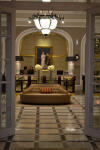 |
 |
LEFT: Living it up in five-star luxury at the Maria Cristina, part of Starwood's prestigious Luxury Collection |
 |
Talk of 'new lodgings', however, doesn't begin to do justice to the opulent new surroundings in which we now found ourselves. Walking into the lobby of the Maria Cristina, part of the exclusive Starwood Luxury Collection portfolio, is undoubtedly the ultimate way to arrive in San Sebastian. First impressions were very good and the front desk staff were genuinely friendly and helpful. Our room was simply stunning, although it soon became apparent that the standard of soundproofing was surprisingly wanting.
We were aware that San Sebastian (Basque: Donostia; Spanish: San Sebastián, with the emphasis on the final 'a') was reckoned to be one of the most successful city / beach resort combinations in Europe, as well as being one of the world's top culinary hotspots. It seemed like a good idea to take an introductory walk before darkness fell. Setting out from our magnificent base on the banks of the Urumea river, we initially headed one block northwards past our equally striking next-door neighbour, the Teatro Victoria Eugenia. Turning westwards at this point and thus saving the Old Town for later, we soon came to the town hall building (Basque: Donostiako Udala; Spanish: Ayuntamiento de Donostia-San Sebastián), in its impressive urban-park setting. Immediately west of our current location were the sweeping outlines of La Concha Beach and the bay of the same name, partially protected from the open sea by the Isla de Santa Clara. We hoped to see more of all of this the next day.
For now, we decided to turn south-eastwards at this point and walk towards San Sebastian's Good Shepherd cathedral (Artzain Onaren / Buen Pastor). This late-nineteenth century neo-Gothic structure gave a sense of being remarkably tall in relation to the building's footprint. The old post office was another notable building in the immediate area. Feeling that we had fulfilled our objective of gaining an overview of the destination, and conscious of the failing daylight, we returned to the Maria Cristina.
 |
 |
 |
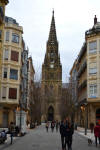 |
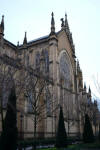 |
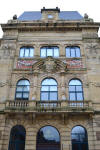 |
 |
 |
 |
|||
| San Sebastian Town Hall Square and La Concha Bay | Good Shepherd Cathedral and the old Post Office building | ||||
| RIGHT: A rather odd name for a cocktail bar! |
 |
 |
With a day's worth of solid sightseeing now under our belts, it seemed only right that the evening programme should begin with a visit to the hotel's sumptuous cocktail bar, which rejoiced in the unlikely name 'Dry'. So-called 'dirty martinis' (dry martinis laced with olive juice) were the order of the day, and very nice they were too.
I have already noted that San Sebastian has a reputation for culinary prowess, and this is in no small part due to excellence in the unlikely-sounding field of bar snacks. They say that tapas were created in Andalusia, but as pintxos - the preferred local name - they were perfected in San Sebastian. (Pintxo is pronounced PEEN-cho, incidentally.) We simply had to sample this tradition for ourselves, and set out for the nearby Old Town in the rain. Although armed with the hotel's beautifully produced guide to the best pintxo bars, we were mainly influenced simply by what we liked the look of. We drank beer at the first stop, but switched to white wine in the other two selected venues. Both Bruce and I were suitably impressed by the whole pintxo culture, with its appetising mix of hot and cold offerings. So many plates of food sitting openly on counters would no doubt have breached UK health regulations, but it seemed to work well enough here! It was a fabulous way to have dinner and indeed to end the day, just moving around and stopping where we liked.
 |
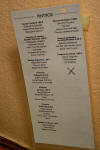 |
 |
 |
 |
 |
 |
 |
 |
 |
 |
|
| A night on the pintxos: after-dark bar hopping in San Sebastian's old town | |||||


















